Abstract
This paper analyses the vegetation system as a matter of design and configuration of the urban green infrastructure of Castelo Banco, Portugal, taking into account the current environmental challenges—air quality, biodiversity and the climate crisis. Being one of the components of nature-based solutions, it explores among its multiple functions those of ecological and cultural order. Furthermore, it deals with integrating the knowledge of phytosociological science into the projectual practice of landscape architecture. Specifically, it explores the choice of the most appropriate vegetation system to be used in order to meet the future needs of this city.
1. Introduction
Urban design is increasingly sensitive to the use of the vegetation system. This scenario has arisen due to economic, environmental, social, territorial and cultural problems. According to the European Commission, environmental challenges include air quality, biodiversity crisis and climate change in cities, among others [].
However, these challenges require a more comprehensive territorial solution including links between urban and rural space [] (p. 4). The actions in this scope are based on the planning and design of a green infrastructure (natural and semi-natural areas) [] (p. 2), where the vegetation system is structuring, contributing to the mitigation of these challenges (improvement in air quality and CO2 reduction, microclimate regulation, regulation of the water cycle, food production and refuge, among others).
To this end, the aim of this article is to investigate a possible selection of plants to be used in this infrastructure in Castelo Branco, which responds to the above-mentioned challenges. In this way, an ecological and cultural approach will be introduced, which will meet the reading and interpretation of the universalistic culture which is the Portuguese landscape. Defined by Viana Barreto and Ribeiro Telles, it is a culture of ecological sensibility with recourse to native vegetation, but also of cultural base where exotic species are used [] (p. 2). This universalistic culture that guides our research is important and fundamental to understand the dynamics of the vegetation system to be used as an open space constructor, mainly in its use in an urban context, where the demands and the control of the species are different from the rural space.
The literature consulted extended to studies in the field of landscape architecture and phytosociology, without restrictions on the year of publication where we sought to identify the works that had already been conducted in relation to the Mediterranean vegetation system for green infrastructures. However, no specific bibliography of articles, books, masters or doctoral theses on green infrastructure and Mediterranean vegetation in Portugal could be found. In this sense, relevant research works concerning the interactions between Mediterranean vegetation and its behaviour in the study area were identified.
Phytosociological science is present in landscape architecture since its foundation in Portugal and has been contributing to the evolution of the profession. The paradigm of ecological sustainability, transversal to all scales of intervention in the landscape, gives relevance to the need for an increasingly solid articulation between the phytosociological science and the practice of landscape architecture.
By considering the contribution of phytosociology in the landscape architecture project, concerning the choice of the vegetation system to be used, the basic teachings of landscape architecture in Portugal were revisited, where it was considered that these principles are well expressed.
In the 1960s, Caldeira Cabral and Ribeiro Telles worked together on the publication of the book, The Tree in Portugal, in which they set out an innovative thinking for the landscape architecture project []. It consists of a proposal with a high degree of sensitivity towards plant life, site values and ecological principles, certainly inherited from the German school [] (p. 155), where the work that gave impetus to phytosociological science emerged [] (p. 71). This book presents the native species of climax forest, and the different groups of plant associations, distributed over the various geographical areas of mainland Portugal, among other plants that are characteristic of the Portuguese landscape. For some of the species, they indicate their ecology, identity, plastic interest, cultural techniques (planting and pruning) and their management. Parallel to this publication, these authors were developing the project for the Calouste Gulbenkian Foundation Garden where they applied this thinking to the conceptual language of the project’s planting plan. The terminology was outdated, but it is possible to understand the principles that the science of phytosociology decoded.
Another important work that drew attention to urban problems and the importance of trees in the urban space was the publication Problems of the Urban Landscape by Ilídio Araújo 1961 [] where he listed the problems of the urban landscape and demonstrated how the vegetation system could contribute to the mitigation of these problems.
More recently the works for Capelo [], Costa [] and Mesquita [] which reflect the pioneering work of Caldeira Cabral and Ribeiro Telles expose what we need by deepening the knowledge of the potential of vegetation in the Portuguese territory. Their proposals present the vegetation system based on the main ecological factors that print distinct units in the landscape. On the other hand, they prove the need to update the vegetation associations proposed in the book The Tree in Portugal.
In 2010, Santos [] states that at the urban scale the methodologies that are supported on natural vegetation or ecological processes lose importance in the understanding of the landscape. We disagree with this reading, as we consider that fostering a system of structures or ecosystems between urban and rural space, the reading should be based precisely on the potential natural vegetation and on the ecological processes, emphasizing the quality or potentiality of the landscape system. It is understood that Santos has a fragmented view of the concept of landscape (which can be rural, urban, industrial space), but that the working principles are always the same.
This vision of the landscape as a continuum is felt in the work of Arsenio [] (pp. 57–58). In what concerns the application of the science of phytosociology in landscape management, the author considers that the study of plant communities allows: the inference of the geodiversity of the territory, as well as its climatic diversity; knowledge of the diversity of the natural plant heritage, responsible for providing environmental services; understanding of the dynamism relations of plant communities; understanding of the influence of ecological factors; and relating all the knowledge obtained with other approaches to landscape study. Although it is a complex study, it becomes evident that this analysis/approach should be taken into consideration for the selection of the vegetation system to be used in urban and peri-urban open spaces by showing the possibility of a wide network of relations with the other urban infrastructures being a unifying element of the open spaces. The evidence of the importance of the theme discussed here was also applied by Raposo [] and Martínez [] by making it a practical case in landscape architecture projects in the district of Évora and in the city of Madrid, respectively. Raposo [] argues that the phytosociological methodology can be applied at the analysis and project proposal stages.
The first resorted to the observation of bioindicators and the second to the lists of vegetation series proposed for the area under study. Martínez [] showed us that the choice of mixed meadows of Mediterranean flora, with extended flowering seasons, to replace typical lawns fostered an increase in biodiversity and the aesthetic interest of their projects. More recently, the project Native Plants in the City—Rethinking Urban Green Spaces promoted the transfer of scientific knowledge of phytosociology and landscape architecture through the creation of an informative technical manual on the vegetation system to be used in the district of Évora []. Associated with this theoretical communication it was possible to design and plant some spaces of the city with low irrigation costs.
From what we could collect from the work conducted in Portugal on these topics, we can say that there is a long way to go to have more updated study supports in these areas that serve to support professional landscape architects and nurserymen, among others.
1.1. Green Infrastructure: The Vegetation System
The concept of green infrastructure includes much more than a green surface, with trees, shrubs and herbaceous plants. It also serves to respond both to ecological functions in the urban space and to social functions by bringing man closer to nature [] (pp. 332–340). In this perspective, we can consider that all the elements that build these open spaces in cities are in themselves a subsystem of the city system (social, cultural, economic, ecological).
In the case of the vegetation system, it articulates and reinforces the morphology of the site. It develops an interrelated pattern of open, closed or semi-closed spaces, where each form fits the planned function. Functions that are both aesthetic and ecological. Essentially, each plant used must serve a purpose and, all together, must contribute to the function and expressiveness of the plan [] (p. 128).
The works of Magalhães [], Telles [], Matos [] and Silva [] refer that this idea of the vegetation system as a structuring element developed in the 19th century. This period marks the artificiality of the industrial city [] and, consequently, several authors try to demonstrate the importance of the green space in the context of the European city in order to live better in the city.
In response to these concerns, the urban open space, known as green space, began to be valued as a structural element of the design. Like the great European metropolises, they wanted to see more gardens, parks and tree-lined avenues. These new spaces with the intention of establishing corridors and avenues of connection, allowing quick access between different points of the cities, were then in great expansion. These spaces are extremely important because they establish the relationship between the natural and cultural dimensions. We are interested in considering relationships of natural and cultural systems that configure the urban space. This idea of continuity in the city is translated into the concept of continuum naturale [], introduced in Portugal by the landscape architect Francisco Caldeira Cabral, which gives rise to other basic concepts of sustainable urban design, such as the concept of urban green structure, which according to Magalhães [] (p. 107) aims to preserve the fundamental structures of the landscape in the urban environment in a continuous and tentacular way, taking different forms and functions, ranging from leisure and recreation space, the framework of infrastructure and buildings, to simple tree-lined streets or squares.
Therefore, it subsists with the better understanding of the ecological and plastic characteristics of the plant element isolated, and the needs of a better quality of life in current cities, which now at the disposal of the city planning constitutes to be the point of balance between the evolution of the city, man and nature. Pessoa [] (p. 103) refers to it as being a vivifying network of the urban environment from all points of view. According to the landscape architects of the time this systemic network of green spaces (also called green infrastructure) contains much more than a green surface, which with trees, shrubs and herbaceous plants also serves to respond to both the ecological functions in the urban space and the social functions bringing man closer to nature. It is in this perspective that we can consider that all the elements that build these open spaces in cities are in themselves a subsystem of the city system (social, cultural, economic, ecological).
The dynamics of wet and dry systems in the landscape are closely related to the distribution of the vegetation system. These systems are determined by the morphology of the terrain and the influence of water and atmospheric runoff []. Wet systems are considered the flat or concave areas, where water and cold accumulate; in contrast, dry systems comprise the areas that have some slope or are convex, which lead to a greater or lesser flow of water and cold air [], see Figure 1.

Figure 1.
Location of the protective forest according to the slope, according to Molkanov in 1963 quoted by Magalhães [] (p. 369).
The distribution of vegetation in these two systems is also determined by the interaction of soil, climate, and terrain morphology factors. In this dynamic we can designate that the edapho-hygrophilous and tempori-hygrophilous vegetation is associated with areas adjacent to the water lines, where water availability is greater. The climatophilous vegetation is associated with the slopes and depends exclusively on the local climate. Finally, the edaphoxerophilous vegetation is associated with headland areas, with poor water retention, such as rocky outcrops [], see Figure 2. For each of these typologies a set of potential natural vegetation is associated. This morphological reading of the landscape in urban space becomes important as, for each urban situation, it allows the identification of the set of plants to be integrated in the vegetation system, with guarantees of better adaptation.
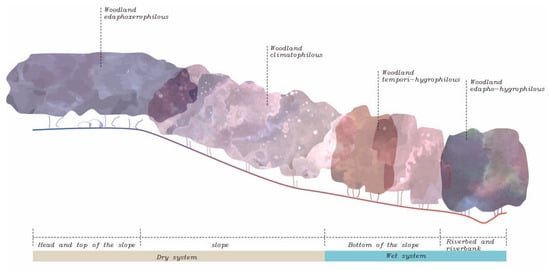
Figure 2.
Location of the forest as a function of slope (adapted from [] (p. 369)).
1.2. Vernacular Knowledge and Choice of Vegetation System
The relationship between cultural and natural diversity is understood as a guideline of the European Landscape Convention, ratified by Portugal in 2005. The document mentions in article 5, under General Measures:
To give legal recognition to the landscape as an essential component of the human environment, an expression of the diversity of its common cultural and natural heritage and the basis of its identity. [] (p. 1026).
It can then be considered that the importance of vernacular knowledge about the vegetation system is sustained in the multiplicity of human relations, throughout history, which characterize a place, a city, a territory, a landscape and forming its character of place, plus an intrinsic ecological value. Thus, revealing a range of possibilities for reflection and action on space. In order to deepen the vernacular knowledge of the vegetation system in Castelo Branco, it was considered fundamental to use as an analysis device the Paço Episcopal Garden, which functions as a laboratory.
Throughout this history (at different political, economic, and social junctures), the vegetation used in the space at different times, from its construction in 1720 to the present day, has been described. The most important plants are laurel, cedar, cypress, olive, citrus, buxus, myrtle and flowering bulbs. To obtain this information we used landscape architecture projects and studies and literary sources from the Paço Garden, Vegetable Garden and Woodland, which revealed the plants used and the date of their introduction into the garden space [,,].
2. Materials and Methods
As previously mentioned, this study has to start from a holistic research process. According to the principles of the Portuguese landscape architecture school, the working methodology followed (Figure 3) for the selection of the vegetation system, comes from the use of universal concepts of both landscape architecture and phytosociological science concretely from the Sigmatist School of Zurich-Montpellier proposed by Braun-Blanquet [], Géhu and Rivas-Martínez []—updated by Rivas-Martínez [].
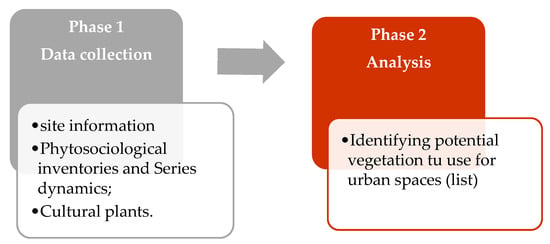
Figure 3.
Scheme of the followed phases for the selection of native plant material.
In this sense, for a better selection of the vegetation system the works of Caldeira Cabral and Ribeiro Telles [], Ilídio de Araújo [] and Aurora Carapinha [] should be followed, complemented by works on phytosociological science of Carlos Pinto Gomes [], José Carlos Costa, Carlos Neto, Carlos Aguiar, Jorge Capelo, Maria Dalila Espírito Santo and Mário Lousã [], among others. These works reflect the pioneering spirit of Caldeira Cabral and Ribeiro Telles in deepening the knowledge of the vegetation potentialities in the Portuguese territory. Their proposals present the vegetation system based on the main ecological factors that give the landscape its distinctive units. The data on the vegetation system used in the investigation were obtained through a bibliographic review of updated works on the two areas of knowledge.
Study Area
The selection of the study area for the present investigation focuses on Mediterranean climate areas because:
- -
- It is the most representative climate of the cities of continental Portugal [];
- -
- It is identified that in cities with a Mediterranean climate there will be a higher risk of events resulting from the climate and biodiversity crisis [];
- -
- It is one of the topics of debate (climate and biodiversity crisis) that requires understanding about a vision both at the level of ecological and cultural solutions for the cities of the future [].
From the point of view of the different bioclimatic classifications of the Mediterranean macro-bioclimate present in Portugal, it becomes interesting to demonstrate for the different climatic floors of ombroclimates (rainwater availability intervals) and thermoclimates (temperature intervals) existing how the vegetation system can be studied.
This study started from the city of Castelo Branco (Figure 4), which is inserted in the landscape unit of Beira Interior [], where siliceous soils (schists or grauvaques and quartzites, with predominance of granites) predominate [], with wavy to gentle slopes intercalated with flat areas. According to Capelo et al. [], it is pluviestational-oceanic mesomediterranean lower sub-humid (Figure 5).
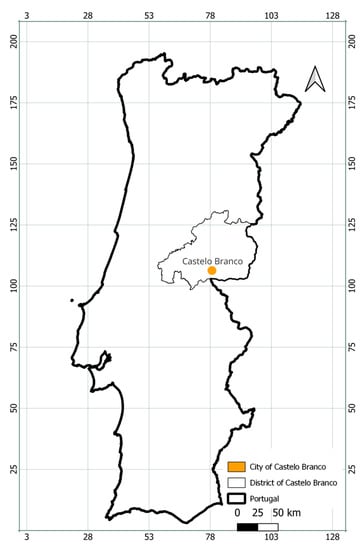
Figure 4.
Location map where the plant material was studied, Castelo Branco, Portugal. 39°49′19.9″ N 7°29′27.1″ W.
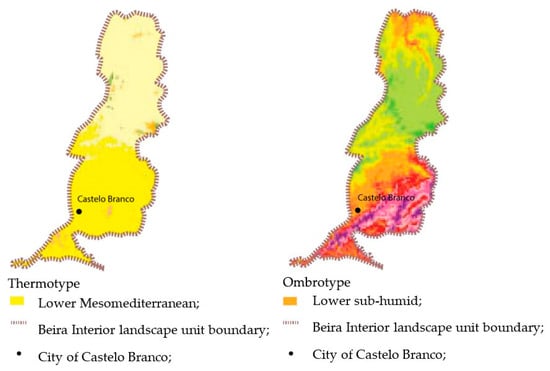
Figure 5.
Thermotype and ombrotype of the city of Castelo Branco.
The urban area of the city of Castelo Branco occupies 1662.51 ha of the municipality (excluding the other urban nuclei of the municipality). We can also affirm that there is still a great proximity between urban and rural areas, where the transition spaces are occupied by vegetation masses that connect them.
From the data made available by the municipality of Castelo Branco, we were not able to ascertain concrete information on the occupied area and the characteristics of the current and projected green infrastructure. These data would allow us a better reflection on its framework, but also on its relationship with the grey and blue infrastructures.
Regarding the analysis of the regulations that accompany the Land Use Planning and Urbanism Plans for the municipality of Castelo Branco, they are extremely imprecise in what concerns the rules for the conception and execution of the vegetation system in the exterior spaces projects. However, there is a clear concern for the selection of plants, where they suggest that the choice be made according to the ecology of the space including species that are part of the potential natural vegetation [].
Further studies will apply this methodology to other Mediterranean macro-climate cities, or other macro-bioclimates, with different thermoclimatic and ombroclimatic relationships.
3. Results and Discussion
Considering the climactic formations (those that depend on the local climate), those that naturally give a better guarantee of development and permanence in space, because their adaptation to the environment is optimal [], may be the right choices for urban and peri-urban spaces, since in this context the temperature oscillations are widely diverse, influenced by external factors.
However, it should be taken into consideration that plants are important in the city because of the capacity they have:
- -
- In improving air quality and reducing CO2. When there is active growth, the vegetation system can reduce atmospheric CO2 in several ways by absorbing CO2 through photosynthesis and by having an insulating role in city buildings [].
- -
- In microclimatic regulation, we know that trees and shrubs combat urban “heat islands”, as shading from the canopy and transpiration from plants (evapotranspiration process) can locally reduce the average temperature by 2–8 degrees. Besides providing a pleasant outdoor environment, this also reduces the need for cooling of buildings [].
- -
- On the contribution to the water cycle, it states that a mature tree can transpire 450 L of water per day. In the process it uses thermal energy equivalent to 1000 MJ to drive the evaporation process. In this way, the city can significantly reduce summer temperatures [].
- -
- In the production of food and refuge to various species, in this case the seeds and fruits are highly appreciated by birds and rodents and the nectar of the flowers by insects []. The productive character of this system is directly related to human well-being by providing food goods that in this case according to European Union policies have to be increasingly contemplated in urban ecological structures, namely by promoting the implementation of agricultural practices/urban gardens (where productive landscapes are articulated in socio-cultural economic and ecological terms). For this, see the concept Continuous Productive Urban Landscape [] (pp. 211–217). It also ensures the creation of biodiversity, habitats and continuity between landscape spaces.
Following the principle of vegetation system design based on plant associations and the dynamics of the series (planting in association), see Figure 6, it allows the recreation of environments characteristic of each system, dry and humid, as well as being based on the use of plant characteristics of each landscape unit in order to promote the (re)creation of habitats. (Each association possessed its own combination of species ecological characteristics of a concrete habitat, corresponding to a structurally stable vegetational stage in the process of succession, as well as in a delimited territory. Vegetation series is a geobotanic notion that tries to express all the plant communities, or collection of stages, that can be found in similar teselar places as a result of the succession processes; so, a Geosigmetum includes not only the representative vegetation type of the mature stage, or head series, but also the initial or subserial communities replacing it []).

Figure 6.
Scheme of a Climatophile Vegetation Series. (1) Woodland; (2) pre-woodland; (3) scrubland; (4) perennial grassland (higher); (5) perennial grassland (low); degraded soils; (6) dwarf-scrub; and (7) annual grasslands.
For this purpose, from phytosociological studies it was identified that the potential climatophilous vegetation of Castelo Branco is dominated by a black oak (Quercus pyrenaica) to the north and by a cork oak (Quercus suber) to the south, where the first is on granites and the second on schist and quartzite substrates, particularly on the cooler slopes. These two vegetation climaxes correspond to two distinct vegetation series.
We identify in this proposal some knowledge gaps for future research. We name three areas of study to improve future proposals of the vegetation system for green infrastructure; it will be important that phytosociological science maps the edaphoxerophilous, climatophilous and hygrophilous vegetation series at the scale of the municipality and not only at the scale of the country. Another study of interest is the inventory of all the plants used so far in the open spaces of the cities and for each city apply the evaluation of sustainability indicators to measure the performance of these species in green infrastructure. Finally, an evaluation study of the ecosystem services provided by green infrastructure should be carried out.
On these two series, the main stages of substitution of the climactic stages of (black-oak and cork oak), as well as the characteristic plants and companions of this potential are presented (the set of plant communities in their respective states of succession is presented) (Figure 7):
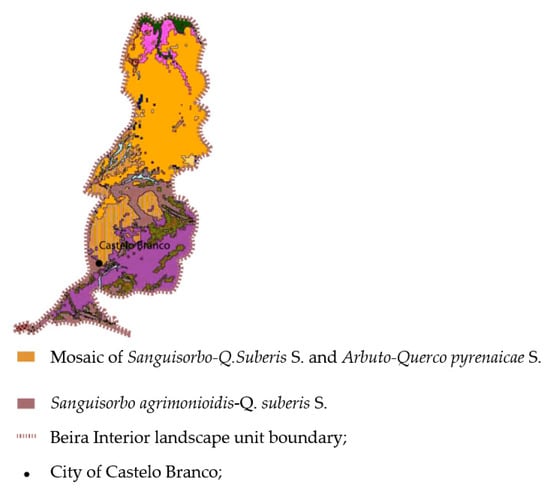
Figure 7.
Vegetation series of the Beira Interior landscape unit.
3.1. The Black Oak Series Defined by Arbuto-Querco Pyrenaica S. [,] Was Replaced by Arisaro Simorrhini-Quercetum Pyrenaicae [] (p. 72)
The dominant stage forms a Quercus pyrenaica woodland termo to mesomediterranean, sub-humid to humid, in siliceous substrates with a predominance of granites. The series includes, besides the climacic stage, the following substitution steps: Phillyreo angustifoliae-Arbutetum unedonis; Cytisetum multifloro-eriocarpi; Melica magnolii-Stipetum giganteae; Centaureo coutinhoi-Dactyletum lusitanici; Polygalo microphyllae-Cistetum populifolii; and Tuberion guttatae. Dynamics based on [] (pp. 70, 78) and [] (pp. 139–140) (Table 1).

Table 1.
Main replacement steps for Arisaro simorrhini-Quercetum pyrenaicae Sigmetum.
3.2. The Cork Oak Series Defined by Sanguisorbo Agrirnonioidis-Querco Suberis [] Was Replaced by Smilaco Asperae—Quercetum Suberis [] (p. 66)
The dominant stage forms a Quercus suber, termo to mesomediterranean, sub-humid, in siliceous substrates [] (p. 131). The series includes, besides the climacic stage, the following substitution steps: Phillyreo angustifoliae-Arbutetum unedonis; Cytisetum multifloro-eriocarpi; Avenulo sulcatae-Celticetum giganteae; Erico australis-Cistetum populifolii; and Halimio ocymoidis-Ericetum umbellatae []. Dynamics based on [] (p. 66) e [] (p. 131) (Table 2).

Table 2.
Main replacement steps for Smilaco asperae—Quercetum suberis Sigmetum.
These results show us the importance of applying this methodology for future works. For the knowledge of the identity of the place through the native vegetation and the memories of a culture give the result of its authentic identity, both for the analysis of the space and for projecting on it.
Thus, on the basis of the previous studies and the bibliographical support for it, the plants with the greatest interest (aesthetic, cultural and ecological) are selected as building material for landscape architecture (Table 3) (Figure 8 and Figure 9).

Table 3.
Summary of the vegetation system proposed in climatophilic position.
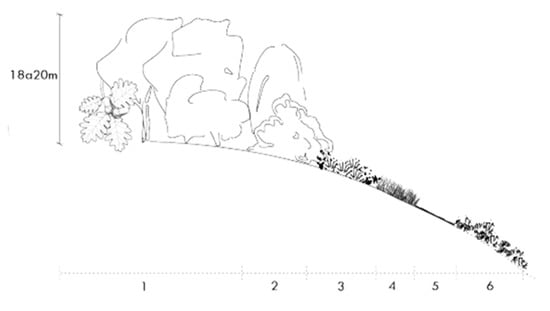
Figure 8.
Typical distribution scheme of black oak in Castelo Branco. Subtitle scheme (1) woodland; (2)pre-woodland; (3) scrubland; (4) perennial grassland (higher); (5) perennial grassland (low); degraded soils; and (6) dwarf-scrub.
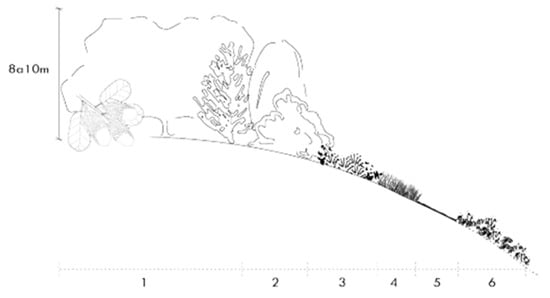
Figure 9.
Typical distribution scheme of the cork oak in Castelo Branco. Subtitle scheme (1) woodland; (2) pre-woodland; (3) scrubland; (4) perennial grassland (higher); (5) perennial grassland (low); degraded soils; and (6) dwarf-scrub.
4. Conclusions
From the results obtained, it can be concluded that the plants that are part of our garden culture have adapted remarkably well to the ecological conditions of Castelo Branco. They have remained so up to the present day and are now included in the list of plants proposed for this system with the plants identified in the phytosociological analysis. More trees, shrubs and some bulbous and other rhizomatous perennials have been added, which, although they do not appear in the bibliography, it is known through contact with some specialists that these species have the potential to occur in these territories.
The value this system represents in urban space depends on its ecological, cultural and plastic functions. The ecological approach to the vegetation system should take into consideration the resilience of the system, production of services that contribute to human well-being and the protection of biodiversity and habitats. Provided that these functions are guaranteed, it should therefore be present in open areas; a design that uses species that best adapt to local soil and climate characteristics and reduces water consumption should prevail; it should foster the continuity of spaces; maintenance should be in harmony with natural evolution. On a cultural level the use of plants must maintain the identity of the Mediterranean landscape culture and on an aesthetic level it must clearly result from the concrete intensions related to the project solution, where this system always fulfils functions of structure, composition and configuration. Thus, the design with this system should be creative, beautiful, accessible, safe and amenable.
Finally, it is considered that this work can be framed as a nature-based solution, since it considers the use of vegetation series, namely at the level of plant associations, as a reference structure in the construction and conservation of the landscape, together with the permanence of our universalistic landscape culture. The value of urban open spaces is related to our landscape systems that regulate and support ecosystem goods and services.
Funding
This research was funded by Foundation for Science and Technology (FCT), and The FCT was funded by European Union (EU), grant number SFRH/BD/138850/2018.
Conflicts of Interest
The author declares no conflict of interest.
References
- UE, Comissão Europeia. Agenda Urbana para a UE—Pacto de Amesterdão; Comissão Europeia: Amsterdam, The Netherlands, 2016. [Google Scholar]
- UE, Comissão Europeia. Avaliação dos Progressos na Aplicação da Estratégia da UE para a Infraestrutura Verde; Comissão Europeia (UE): Brussels, Belgium, 2019. [Google Scholar]
- Barreto, A.V.; Telles, G.R. Anteprojecto—Memória Descritiva; Fundaçao Calouste Gulbenkian Sede e Museu: Lisbon, Portugal, 1961; Available online: https://cdn.gulbenkian.pt/arquivo-digital-jardim/wp-content/uploads/sites/29/2015/09/SPO-00024.00001.pdf (accessed on 26 April 2023).
- Cabral, F.C.; Telles, G.R. A Árvore em Portugal; Assírio & Alvim: Lisbon, Portugal, 1960. [Google Scholar]
- Silva, M. As Plantas no Jardim do Século XX na Tradição Ocidental. Évora, Portugal: Trabalho Fim de Curso—Licenciatura em Arquitectura Paisagista Apresentada à Universidade de Évora. Master’s Thesis, Universidade de Évora, Évora, Portugal, 2003. [Google Scholar]
- Arsénio, P. Qualidade da Paisagem e Fitodiversidade—Contributo para o Ordena Mento e Gestão de Áreas Costeiras de Elevado Valor Natural; Universidade Técnica de Lisboa—Instituto Superior de Agronomia: Lisbon, Portugal, 2011. [Google Scholar]
- Araújo, I. Problemas de Paisagem Urbana; Ministério Das Obras Públicas—Direcção Geral dos Serviços de Ur-banização: Lisbon, Portugal, 1961. [Google Scholar]
- Capelo, J.; Aguiar, C. A Vegetação de Portugal, 1st ed.; Imprensa Nacional—Casa da Moeda, Câmara Municipal de Lisboa: Lisbon, Portugal, 2021. [Google Scholar]
- Costa, J.C.; Aguiar, C.; Capelo, J.; Neto, C. Vascular plant communities in Portugal (continental, Azores and Madeira). Glob. Geobot. 2012, 2, 1–180. [Google Scholar]
- Mesquita, S.; Sousa, A.J. Bioclimatic mapping using geostatistical approaches: Application to mainland Portugal. Int. J. Clim. 2009, 29, 2156–2170. [Google Scholar] [CrossRef]
- Santos, T. Fitossociologia e Paisagem da Bacia Hidrográfica do Rio Paiva; Universidade Técnica de Lisboa—Instituto Superior de Agronomia: Lisbon, Portugal, 2010. [Google Scholar]
- Raposo, M. O Interesse das Séries de Vegetação no Projeto em Arquitetura Paisagista (Distrito de Évora). Master’s Thesis, Universidade de Évora, Évora, Portugal, 2013. [Google Scholar]
- Martínez, M. Biodiversidade em Espaço Urbano: Alternativas ao Uso Extensivo de Relvados no Contexto Mediterrânico; Universidade de Évora: Évora, Portugal, 2014. [Google Scholar]
- Belo, A.; Pinto-Cruz, C.; Meireles, C.; Castro, C.; Machado, M.; Simões, P.; Matos, R. Plantas Nativas na Cidade—Manual Técnico; Universidade de Évora: Évora, Portugal, 2020; ISBN 978-972-778-185-0. Available online: https://www.med.uevora.pt/pt/documentos/ (accessed on 15 February 2023).
- Telles, G.R. A Cidade e a Paisagem Global do Século XXI. In A Utopia e os Pés na Terra; Instituto Português de Museus: Lisbon, Portugal, 2003; pp. 332–340. [Google Scholar]
- Simonds, J.O. Landscape Architecture—A Manual of Site Planning and Design, 2nd ed.; McGraw-Hill, Inc.: New York, NY, USA, 1983. [Google Scholar]
- Magalhães, M.R. A Arquitetura Paisagista: Morfologia e Complexidade, 1st ed.; Estampa: Lisbon, Portugal, 2001. [Google Scholar]
- Matos, R. A Reinvenção da Multifuncionalidade da Paisagem em Espaço Urbano–Reflexões. Ph.D. Thesis, Universidade de Évora, Évora, Portugal, 2010. [Google Scholar]
- Silva, A. O Pensamento Ecossistémico no Projecto da Paisagem: Uma Reflexão Sobre a Integração de Conceitos Ecológicos na Prática Projetual da Arquitectura Paisagista Contemporânea. Ph.D. Thesis, Universidade de Lisboa, Lisbon, Portugal, 2015. [Google Scholar]
- Telles, G. Paisagem Global; Um conceito para o futuro. In Filosofia da Paisagem—Uma antologia; Veríssimo Serrão, A., Ed.; Centro de Filosofia da Universidade de Lisboa: Lisbon, Portugal, 2011; pp. 475–485. [Google Scholar]
- Pessoa, F. Intervir na Paisagem; Argumentum: Lisbon, Portugal, 2017. [Google Scholar]
- Rivas-Martínez, S. Les étages bioclimatiques de la végétation de la Péninsule Ibérique. An. Jardín Botánico Madr. 1981, 37, 251–268. [Google Scholar]
- Ministério dos Negócios Estrangeiros. Decreto n.º 4/2005, de 14 de Fevereiro, Diário da República: Série I-A, n.º 31/2005; Aprova a Convenção Europeia da Paisagem, feita em Florença em 20 de Outubro de 2000; Ministério dos Negócios Estrangeiros: Lison, Portugal, 2005; pp. 1017–1028. [Google Scholar]
- Attlee, H. O Esplendor dos Jardins de Portugal; Inapa: Lisbon, Portugal, 2008; pp. 120–125. [Google Scholar]
- Carita, H.; Cardoso, A. Tratado da Grandeza dos Jardins em Portugal; Quetzal: Lisbon, Portugal, 1987. [Google Scholar]
- Andresen, T. Jardins Históricos de Portugal. Memória & Futuro; Associação Portuguesa dos Jardins Históricos: Lisbon, Portugal, 2021. [Google Scholar]
- Braun-Blanquet, J. Essai sur les notions d’élement et de territoire phytogéographiques. Arch. Sci. Phys. 1919, 5, 497–512. [Google Scholar]
- Géhu, J.M.; Rivas-Marítnez, S. Notions Fondamentales de Phytosociologie in Syntaxonomie; J. Cramer: Vaduz, Liechtenstein, 1981. [Google Scholar]
- Rivas-Martínez, S. Mapas de series, geoseries y geopermaseries de vegetacíon de Espanã (Memoria del mapa de vege-tacíon potencial de España). Itinera Geobot. 2007, 17, 5–436. [Google Scholar]
- Araújo, I. Arte Paisagista e Arte dos Jardins em Portugal; D.G.S.U: Lisbon, Portugal, 1962. [Google Scholar]
- Carapinha, A. Da Essência do Jardim Português. Ph.D. Thesis, Universidade de Évora, Évora, Portugal, 1995. [Google Scholar]
- Pinto-Gomes, C.; Paiva-Ferreira, R.; Meireles, C. New proposals on Portuguese vegetation. Lazaroa 2007, 28, 67–77. [Google Scholar] [CrossRef]
- Capelo, J.; Mesquita, S.; Costa, J.; Ribeiro, S.; Arsénio, P.; Neto, C.; Monteiro-Henriques, T.; Aguiar, C.; Honrado, J.; Es-pírito-Santo, D.; et al. A methodological approach to potential vegetation modeling using GIS techniques and phytosociological expert-knowledge: Application to mainland Portugal. Phytocoenologia 2007, 37, 399–415. [Google Scholar] [CrossRef]
- Ribeiro, O. O Mediterrâneo e o Atlântico, Esboço de Relações Geográficas, 4th ed.; Sá da Costa, L., Ed.; Colecções “Nova Universidade”: Lisbon, Portugal, 1986. [Google Scholar]
- EEA. Urban Adaptation to Climate Change in Europe. Challenges and Opportunities for Cities Together with Supportive National and European Policies; European Environment Agency: Copenhagen, Denmark, 2012. [Google Scholar]
- Cancela d’ Abreu, A.; Pinto Correia, T.; Oliveira, R. Contributos para a Identificação e Caracterização da Paisagem em Portugal (Continental); Direcção-Geral do Ordenamento do Território e Desenvolvimento Urbano: Lisbon, Portugal, 2002. [Google Scholar]
- Pinto-Gomes, C.J.; Ladero Álvarez, M.; Gonçalves, C.C.C.; Paiva Ferreira, R. Contribuição para o Estudo dos Bosques, Supramediterrânicos de Quercus pyrenaica na Reserva Natural da Serra da Malcata. Quercetea 2004, 4, 13–214. [Google Scholar]
- Presidência do Conselho de Ministros. Resolução do Conselho de Ministros n.º 49/2003; Diário da República n.º 76/2003, Série I-B de 2003-03-31; Presidência do Conselho de Ministros: Lisbon, Portugal, 2003; pp. 2066–2077. [Google Scholar]
- Bolund, P.; Humnhammar, S. Ecosystem services in urban areas. Ecol. Econ. 1999, 29, 293–301. [Google Scholar] [CrossRef]
- Raposo, M.; Mendes, P.; Cano-Ortiz, A.; Pinto-Gomes, C. Séries de vegetação prioritárias para a conservação no centro e sul de Portugal continental. Botanique 2016, 1, 113–148. [Google Scholar]
Disclaimer/Publisher’s Note: The statements, opinions and data contained in all publications are solely those of the individual author(s) and contributor(s) and not of MDPI and/or the editor(s). MDPI and/or the editor(s) disclaim responsibility for any injury to people or property resulting from any ideas, methods, instructions or products referred to in the content. |
© 2023 by the author. Licensee MDPI, Basel, Switzerland. This article is an open access article distributed under the terms and conditions of the Creative Commons Attribution (CC BY) license (https://creativecommons.org/licenses/by/4.0/).